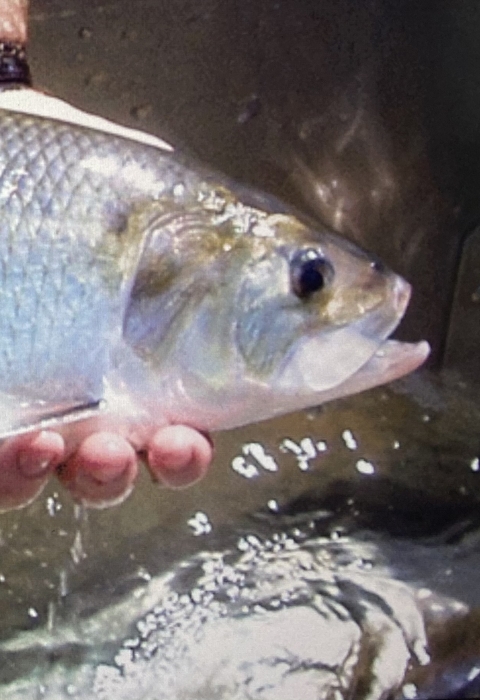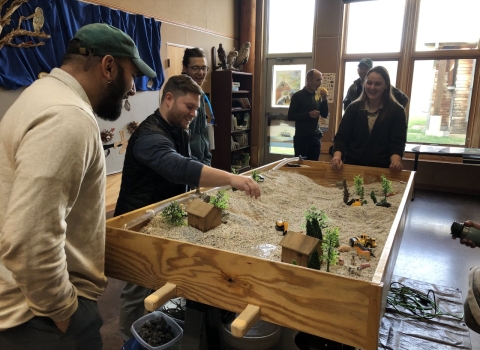What We Do
The Central New England FWCO's goal is to protect and restore migratory and resident fish species and their habitat in the rivers of New Hampshire, Massachusetts, Connecticut, Rhode Island, Southern Maine and Southeastern New York. Our priority fish species include river herring (blueback herring and alewife), American shad, American eel, sea lamprey, striped bass and brook trout, however, all migratory and resident aquatic species benefit from this work. The FWCO also works closely with the States of Massachusetts and New Hampshire to assess the status and improve habitat for migratory fish in the Merrimack River basin, which extends from the White Mountain region of New Hampshire to east-central Massachusetts.
- Partner with the Atlantic States Marine Fisheries Commission to assess the status and health of migratory fish and make recommendations for their protection, restoration and harvest.
- Collaborate on relicensing hydroelectric projects to improve access to historic spawning areas for migratory fish and to ensure compliance with Federal Energy Regulatory Commission (FERC) environmental requirements.
- Restore aquatic connectivity by replacing undersized culverts, dam removals and the installation of fishways to ensure passage and enhance flood resiliency.
Management and Conservation
Migratory Fish Restoration Benefits Everyone!
Each spring, hundreds of thousands of fish migrate from the ocean to our coastal rivers: Alewife and blueback herring, American eel and American shad, sea lamprey, and striped bass. These fish are ecologically, culturally and economically important to the region as a food source for people and for other fish and wildlife, including fish and wildlife that people like to eat.
Alewife and Blueback herring were almost considered endangered, but they are beginning to show improvement in a few rivers. A moratorium on commercial fishing, however, remains in place in Connecticut, Massachusetts, Rhode Island, Maryland and North Carolina, and in some rivers in Virginia. Some states offer a catch and release recreational fishing program. Learn more about river herring natural history.
American shad were greatly affected by pollution and dams, and their numbers are still well below historical levels throughout their range. Learn more about American shad natural history.
American eel once made up over a quarter of the total fish found in Atlantic coastal streams. Biologists are working on ways to move eels up and downstream of dams.
We are working to improve river habitat and open up rivers so all species of migratory fish can reach important spawning and nursery grounds.
Habitat Restoration
Starting as early as the mid 1600’s milling, manufacturing and transportation infrastructure fragmented watersheds in Massachusetts, New Hampshire and all over the East Coast. Dams and undersized road crossings have segmented habitat on every major river system in New England. Fragmentation is the number one stressor of migratory and resident aquatic species by impeding fish passage fish passage
Fish passage is the ability of fish or other aquatic species to move freely throughout their life to find food, reproduce, and complete their natural migration cycles. Millions of barriers to fish passage across the country are fragmenting habitat and leading to species declines. The U.S. Fish and Wildlife Service's National Fish Passage Program is working to reconnect watersheds to benefit both wildlife and people.
Learn more about fish passage to historic spawning habitat, coldwater refuge streams and feeding grounds. They are often undersized, which will not only erode the downstream river bed, creating an impassable height barrier, but will leave the crossing vulnerable to flooding and failure. Restoring aquatic organism passage is important for the protection and restoration of fish and their habitats as well as improved resiliency to flooding and infrastructure damage.
Working in partnership with Federal, State, municipalities and local conservation groups, the Central New England FWCO is assessing and evaluating barriers to fish passage in New Hampshire, Massachusetts, Rhode Island, Southern Maine, Connecticut and Southeastern New York. Through programs such as the National Fish Passage Program, Eastern Brook Trout Joint Venture and the Atlantic Coastal Fish Habitat Partnership, the Central New England FWCO and its partners have been able to open hundreds of miles of rivers and streams by removing fish passage barriers. Barrier removal or remediation, combined with in-stream habitat restoration, will restore access to historical spawning areas and allow for needed seasonal migration of fish to upstream and downstream areas. Appropriately designed road crossings also greatly increase flood resiliency, lower phosphorus loading and restore the stream's natural gradient, sediment transfer and geomorphic state.
Our Projects and Research
Across the landscape, undersized, aging and improperly placed road-stream crossings create barriers in our rivers, streams, and tidal wetlands. These structures fragment aquatic habitat and prevent or greatly reduce the ability of aquatic species to move freely to migrate, feed, and reproduce. These poorly designed structures are also more prone to clogging, causing flooding, and washing out...





